Abstract
The distribution of algal biodiversity is important for better understanding the factors controlling ecosystem functioning in harsh Arctic and sub-Arctic habitats. In this region, diatoms are the most representative and best indicators of environmental parameters. Here, we analyzed the distribution of 1268 diatom species across 18 islands within the Conservation of Arctic Flora and Fauna (CAFF) region based on our own and published data. To assess the representativeness of these floras, we examine genus–species associations, a method applicable to future algal flora studies. Diatom diversity is sufficiently high across the islands, with species richness decreasing toward higher latitudes. Species–area relationship models indicate that latitude—and even more so factors describing climatic extremes, like BIO19 (19 standard bioclimatic variables)—affects species richness stronger than islands area, and combined environmental and geographic predictors explain up to 81% of the observed variation. Bioindicator analysis reveals an increase in water pH, content in organic matter, and the number of eutrophic and mixotrophic species southward, which correlates with rising temperatures, as shown by the BIO19 and DHI (Dynamic Habitat Index) environmental indices. The latitudinal distribution of bioindicators demonstrates the ecological response of diatom communities to climatic factors and allows the identification of key indicator groups experiencing optimal conditions. So, island diatom species prefer benthic and planktonic–benthic habitats, well-oxygenated waters with low salinity, and moderate temperatures, which prevail on all islands except Vancouver Island, located outside the CAFF (Conservation of Arctic Flora and Fauna) region. A comparative analysis of bioindicators as a response to Arctic conditions of island diatoms revealed circumpolar similarities, connections with the corresponding parts of the Eurasian and North American continents, as well as similarities in the conditions of the islands closest to the pole. Almost a third of the island diatom list (324 species) was assigned IUCN (International Union for Conservation of Nature) vulnerability categories, 112 of which were in the three most threatened categories (Ex, Cr, and En) with their number increasing southwards, but 944 species have not been evaluated yet.
Keywords:
diatoms diversity; ecology; bioindicators; endangered species; IUCN; permafrost; Arctic islands; CAFF region 1. Introduction
Studying the diversity of organisms in the Arctic is a high priority because it can be an indicator of the impact of changing climate conditions []. Of importance is the impact not only of climate warming [], which is currently receiving considerable attention, but also the impact of low-temperature conditions on the diversity and functioning of aquatic ecosystems []. Diversity monitoring is carried out in countries that have Arctic territories within their borders; they are united in the organization called The Arctic Biodiversity Assessment (ABA) []. By this, Arctic Council, which is the leading intergovernmental forum promoting cooperation in the Arctic, aims to protect the Arctic biodiversity from anthropogenic impacts and to monitor climate change [].
Investigating patterns of algal biodiversity distribution is important to better understand the factors that control ecosystem functioning in Arctic and sub-Arctic habitats if we are to adequately respond to projected climate change [,,]. Mechanisms for the distribution and maintenance of biodiversity are crucial for the effective conservation of aquatic ecosystems, as diverse biological communities not only reflect changing environmental factors but also provide essential ecosystem services [,]. However, increasing environmental pressures and climate change pose a serious threat to aquatic biodiversity. One of the most diverse and informative components of aquatic ecosystems is algae [], the first trophic level in the transformation of inorganic matter into organic matter []. Responses to environmental change can be tracked by studying algal diversity, which is used in bioindication []. Diatoms have attracted particular attention as indicators not only of environmental changes over time [], but also as indicators of climate change []. A comparison of Arctic and Antarctic diatom communities in island habitats reveals significant differences between the polar zones [], which are distinguished by their unique species composition. Therefore, monitoring community changes specifically in a specific polar zone must be conducted separately. For this purpose, the Arctic Biodiversity Monitoring Network (CAFF) was created [,]. It should be noted that the composition of diatom communities in Arctic continental waters and on its islands exhibit significant differences [,]. However, climate change is leading to changes in species composition, as demonstrated in a number of studies [], and is more closely related to climate change than to anthropogenic impact in the planet’s sparsely developed Arctic zone which is totally in permafrost []. Our research in recent years has drawn attention to the diatom flora of the Arctic islands located in the CAFF region [,], which shows not only a surge in diversity, like a hotspot compared to the continent, but also high indicator capacity.
However, to identify patterns of change in the Arctic biota, it is necessary to study not only the species composition of living organism diversity but also identify patterns of its distribution and the relationship with environmental parameters that influence this process. We believe diatoms to be the most stable and suitable for floristic analysis, as they vegetate regardless of the polar day/night cycle and persist in bottom sediments, leaving a record of their habitat conditions and their changes. The harsh Arctic conditions do not lead to the seasonal extinction of diatom communities, thereby leaving a trace of changes that can be tracked using bioindication. Island floras were used for comparison, since within the CAFF region, islands comprise the harshest zone of the High Arctic and are also distributed across most of the Lower Arctic, along with some parts of the continents. Only in the Sub-Arctic zone does the surface of the continents occupy a significant portion (Figure 1). Our objective was to identify the studied diatom floras on the islands within the CAFF region and compare their diversity with the magnitude and spatial distribution of environmental parameters using bioindication and statistics methods to determine the main patterns of distribution of diatom diversity and the main shaping factors of the environment.
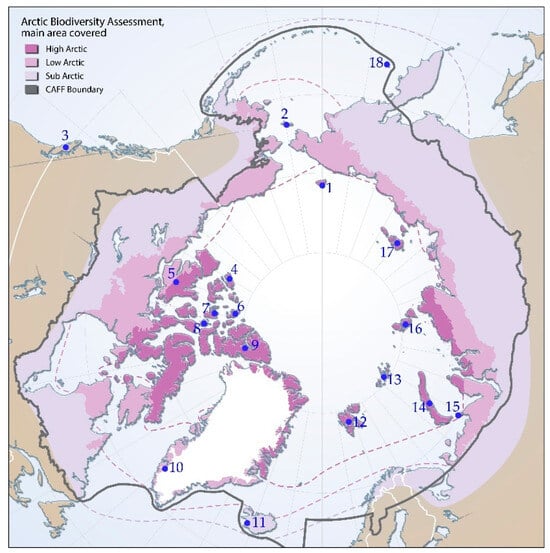
Figure 1.
Location of 18 islands in the CAFF region. Floristic sites (blue dots with number) for comparison of islands diatom diversity within the Arctic freshwater boundaries from the Conservation of Arctic Flora and Fauna (CAFF) (black line) []. The climatically sharp zones are divided into three sub-regions of the Arctic, namely the High Arctic (dark purple), Low Arctic (purple), and Sub-Arctic (light purple). The dash lines marked borders between each zone. The number of floristic sites is organized in order of the island’s longitude. Description of each number of sites is given in Table 1.
Therefore, we decided to investigate changes in the species composition of diatom communities on Arctic islands located in the CAFF region and its relationship with the main climatic parameters of this zone. Only island systems in the CAFF region for which island parameters, coordinates, and area are known, as well as for which a sufficiently rich list of diatom algae that is available from our own and published studies, were selected for analysis.
The following objectives were set as follows: (1) obtain original data on diatom’s diversity of Kotelny and New Zemlya Islands; (2) collect and unified data about diatom diversity from Arctic islands in CAFF region; (3) determine the sufficiency of the species composition of each island for comparative floristic analysis; (4) identify the taxonomic features of the distribution of diatom diversity by island latitude; (5) determine the indicator properties of species on each island and compare them by indicator types in a latitudinal aspect; (6) identify the relationship between diatom diversity and the basic climatic parameters of the islands in a latitudinal aspect; and (7) establish the distribution of protected diatom species by IUCN categories and their dynamics in a latitudinal aspect.
2. Materials and Methods
2.1. Site Description
The Arctic zone is characterized by unique climatic parameters, including periodic long-term insolation or equally long periods of absence of solar radiation. Biodiversity studies are mandated by international agreements within the CAFF region [] outlined in Figure 1. As can be seen in Figure 1, the zone is divided into climatically homogeneous belts called High Arctic, Low Arctic, and Sub-Arctic. The CAFF region is composed of roughly equal parts of continents and the Arctic Ocean, with the North Pole remaining in the center and having no landmasses nearby. However, the continental margins are highly indented and contain a significant number of islands located in all three CAFF zones.
The most thoroughly studied diatom floras of the CAFF Islands were selected for analysis. Table 1 shows that of the 18 floras, organized by location from east to west, the floras of islands 1, 13, and 18 falls within Russia’s zone of responsibility, while islands 14 and 17 were surveyed by us. The majority of the studied floras (3–9) fall within Canada’s zone of responsibility.
2.2. Principle of Selection of Data on Biodiversity and Climate Parameters
The present study draws on the authors’ own research and data collected from published articles on Arctic island diatoms. Figure 1 shows the distribution of island diatom floras within the CAFF region analyzed, and Table 1 shows the key location and area parameters of the 18 islands where diatoms were studied.
To assess the impact of climatic factors in the Arctic zone on organismal diversity, the following data were collected. Biodiversity was assessed based on the principle of data homogeneity. Only one group of photosynthetic organisms was selected, the diatoms from surface water bodies. The database included only those diatom floras that have been sufficiently studied, only those floras that inhabit islands (that is, those whose species diversity relationships can be traced across isolated areas), and only those that cover as much of the CAFF region as possible. Diatom diversity data were compiled from our own data published about the Arctic islands floras [,,] as well as the diatom lists from reputable publications [,,,,,,,,,,,,,,,,,,,,,,,,,,,,,,,,]. Diatom lists were summarized for 18 Arctic islands (Table 1, Figure 1). The taxonomic nomenclature was updated for each list in accordance with the online database Algaebase.org [].

Table 1.
The diatom diversity sites position of Arctic Islands in the CAFF region with averaged coordinates, abbreviated names, region, and area.
Table 1.
The diatom diversity sites position of Arctic Islands in the CAFF region with averaged coordinates, abbreviated names, region, and area.
| Site No. | Name | Region | Abbreviation | Latitude | Longitude | Area, km2 | References |
|---|---|---|---|---|---|---|---|
| 1 | Wrangel Island | Russian Arctic | Wr | 71°14′00″ N | 179°25′00″ W | 7600 | [] |
| 2 | St. Lawrence Island | Alaska | SL | 63°21′44″ N | 170°16′02″ W | 4640 | [] |
| 3 | Vancouver Island | Canada’s Pacific Coast | Va | 49°36′00″ N | 125°30′00″ W | 32,100 | [] |
| 4 | Prince Patrick Island | Northwest Territories of Canada | PP | 76°45′02″ N | 119°30′12″ W | 15,848 | [,] |
| 5 | Victoria Island | Northwest Territories of Canada | Vi | 70°25′00” N | 107°45′00” W | 217,291 | [,,,,] |
| 6 | Ellef Ringnes Island | Canadian High Arctic | ER | 78°30′00″ N | 102°15′00″ W | 11,295 | [,] |
| 7 | Bathurst Island | Canadian High Arctic | Ba | 75°46′00” N | 99°47′00″ W | 16,042 | [,,,] |
| 8 | Cornwallis Island | Canadian High Arctic | Co | 75°08′00″ N | 95°00′00″ W | 6995 | [] |
| 9 | Ellesmere Island | Canadian High Arctic | El | 79°50′00” N | 78°00′00” W | 196,236 | [,,,,,,,,,] |
| 10 | Greenland—7 points | Greenland | G | 64°10′00” N | 51°43′00″ W | 2,166,086 | [,] |
| 11 | Iceland | Iceland | Ic | 64°08′00” N | 21°56′00″ W | 103,125 | [,,] |
| 12 | Svalbard Islands | Norway | Sv | 78°13′00” N | 15°39′00″ E | 62,045 | [,,,] |
| 13 | Franz Josef Land | Russian Arctic | FJ | 80°34′00″ N | 54°47′00″ E | 16,134 | [,,] |
| 14 | New Zemlya | Russian Arctic | NZ | 73°57′09″ N | 56°20′55″ E | 83,000 | [,] |
| 15 | Vaygach Island | Russian Arctic | Vy | 69°59′49″ N | 59°34′44″ E | 3383 | [] |
| 16 | Severnaya Zemlya Island | Russian Arctic | SZ | 79°30′00″ N | 97°15′00″ E | 37,000 | [] |
| 17 | Kotelnyy–Anzhu Island | Russian Arctic | KA | 75°20′00” N | 141°00′00″ E | 23,165 | [,] |
| 18 | Bering Island | Russian Arctic | Be | 55°00′03″ N | 166°16′23″ E | 1667 | [] |
The database of climatic environmental variables was selected to exclude data on fluctuations in local parameters, such as water indicators in the studied water bodies, but to select climate-related and uniform variables for the entire Arctic zone, but ones that would be known for each island. In total, 19 standard bioclimatic variables were included from the World Climate website [], 3 vegetation-related remote indices (Dynamic Habitat Index, DHI) derived from the Moderate Resolution Imaging Spectroradiometer (MODIS) [], and 2 from PET (Potential Evapotranspiration) [] (Supplementary Tables S1 and S2).
2.3. Estimating the Exploration Level of the Studied Floras
To assess the exploration level of the diatom floras on the studied islands, we applied an empirical rule established by Willis []. According to the rule, in well-explored biota, the distribution of genera G by the number of species they contain S follows a decreasing power law. Notably, the rule was shown to hold not only for entire biotas but also for individual taxonomic groups. In its logarithmic form, Willis’s rule implies a decreasing linear dependence between lnG and lnS:
where a0 and aS are positive coefficients.
lnG = a0 − aS·lnS
Given the high degree of universality of Willis’s rule, which has been repeatedly confirmed across various taxa and regions, it can serve as a criterion for exploration completeness: if the observed distribution of genera by species number conforms to the rule, the flora may be considered well explored []. Here, we evaluate the degree of fit to Willis’ rule using the Pearson correlation coefficient between lnG and lnS, which is expected to be significantly negative. The correlation analysis was performed in JASP 0.18.3 [].
2.4. Modeling Species–Area Relationships and Their Climatic Sensitivity
To test for association between species richness and island area (and, potentially, also with environmental factors), we examined two commonly used types of species–area relationship (SAR) models: (i) the log–log models originally proposed by Arrhenius [] and later popularized by MacArthur and Wilson [,] in the context of island biogeography, and (ii) the semi-log models proposed by Gleason []. The original Arrhenius model relates the equilibrium number of species S in a given region to its area A via a power law, which takes a linear form when log-transformed. In contrast, according to the Gleason model, the number of species S—not its logarithm—increases linearly with the logarithm of area A []. Thus, the two baseline models share a linear dependence on lnS but differ in the dependent variable—either lnS or S. We then extended each of these baseline models by allowing the regression coefficients to vary with additional climate-related factors, rather than remaining constant. Specifically, we considered three scenarios involving climate-related factor C: (1) C affects only the intercept; (2) C affects only the slope; and (3) C affects both the intercept and the slope of the baseline SAR model. The full set of obtained models is summarized in Table 2.

Table 2.
Species–area relationship models with climate-related extensions.
For the climatic extension, we considered a vast set of factors that may serve as proxies for the severity of environmental conditions and the availability of energy. These included latitude; the Arctic biodiversity monitoring zone, as defined by CAFF []; monthly temperature, precipitation, and solar radiation throughout the year []; 19 standard bioclimatic variables [], augmented with potential evapotranspiration (PET) []; and three vegetation-related remote indices derived from the Moderate Resolution Imaging Spectroradiometer (MODIS) []. The coefficients in the examined SAR models were estimated using linear ordinary least squares regression. The regression analysis was performed in JASP 0.18.3 [].
2.5. Bioindication and Statistics
Bioindicator analysis was performed according to [] with species-specific ecological preferences of revealed indicator taxa. Algae are predominantly autotrophic organisms, occupying the first trophic level of the ecosystem pyramid. Thus, they participate in the formation of organic matter, utilizing trophic elements such as nitrogen and phosphorus ions, among others. Nutrient content influences not only algal abundance but also their species composition. Thus, algal abundance and species composition are considered when using the bioindication method. The relationship between algal biodiversity and environmental conditions is determined by the level of adaptation of the species and the community as a whole. Bioindication is based on the principle of correspondence between community composition in nature and various environmental factors. Knowing data on the ecological preferences of algal and cyanobacterial species can be used for bioindication of community habitats.
The method is based on the observation that the occurrence of algal and cyanobacterial species in an aquatic environment reflects water pH, salinity, oxygen saturation, organic pollution, and several other environmental parameters (12), as well as the nutrition type and trophic state of the aquatic ecosystem. The ranges of environmental factors in which a species develops optimally (with the greatest abundance) are the ecological preferences of that species, and vice versa. If a species and its abundance are known, it is an indicator of a given range of environmental factors. However, the bioindication method is based on the species composition of a community and the ecological preferences of its constituent species with their own abundance. Thus, analysis of the species composition of algal communities is the main stage of bioindication, followed by correlating species with their known ecological preferences and summarizing the information for the entire identified community. Each species can be an indicator of several environmental parameters. The environmental variables in which the algal community lives, their amplitudes, and correspondence with the identified indicator category groups for each indicator are classified and described in detail in [].
The BioDiversity Pro 2.0 program was used for similarity calculation []. Pearson coefficients calculation was conducted in [].
Potentially rare and endangered species in our list were correlated with data from a regional resource of well-studied diatoms in Central Europe [] and IUCN (International Union for Conservation of Nature) categories [].
The network analysis in JASP (Jeffreys’s Amazing Statistics Program), significant only (more than 50% similarity), was conducted on the botnet package in the R Statistica package of [].
3. Results
3.1. Climate-Related Environmental Parameters
Before analyzing the correlations between climate parameters and biodiversity, we plotted the environmental parameters against the latitude of the island under study. Figure 2 shows that as the island’s latitude decreases, the climate-related environmental parameters increase in value. Therefore, this consistent increase can be considered a guideline for analyzing the distribution of diatom community diversity across the latitude gradient of the islands under study (Supplementary Table S2). At the same time, the dynamics of the BIO climate indices (Supplementary Table S1) show an increase in temperature and precipitation with decreasing latitude. Solar radiation, an important indicator for photosynthetic organisms, especially during the polar night, was highest in May and June. However, an increase in solar radiation energy with decreasing latitude was observed only in the winter months, while it decreased in the summer.
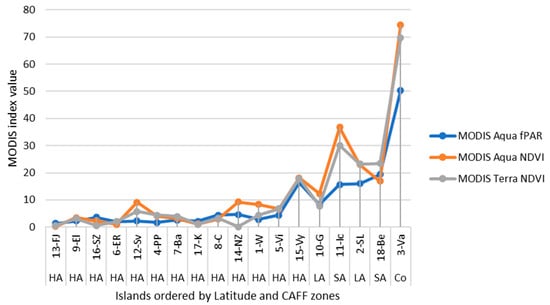
Figure 2.
Distribution of climatic indices MODIS over the studied islands in CAFF region (Ha, High Arctic; LA, Low Arctic; Sa, Sub-Arctic; Co, outside CAFF). Number and abbreviation of islands as in Table 1. The studied Islands are in order of decreasing latitude.
3.2. The Diatom Floras on the Studied Islands
Altogether, 1268 species of diatom algae were found in 18 islands’ waterbodies and included to the database list (Supplementary Table S3). The identified number of diatom species on each island ranges from 52 to 620, with an average of 159 species (Table 3). Given the significant range of species diversity in the island floras, our next task was to determine the representativeness of the identified lists for each island for comparative floristic analysis and an analysis of the relationship with habitat parameters. Table 3 represents the diatom diversity variables in studied islands. Number of Genera correlates to total species number; the index of intraspecific variability is higher in some islands of High Arctic but index of species number per area of islands has an opposite tendency (Figure 3).

Table 3.
Biological variables of the diatom diversity of High Arctic islands.
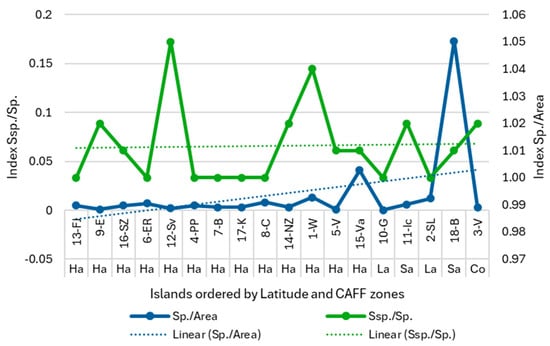
Figure 3.
Distribution of diversity indices Ssp./Sp. and Sp./Area over the studied islands in CAFF region (Ha, High Arctic; La, Low Arctic; Sa, Sub-Arctic; Co, outside CAFF). Number of islands as in Table 1. The studied islands are in order of decreasing latitude. The linear trend lines are dashed.
3.3. The Exploration Level of the Diatom Floras on the Studied Islands
To assess the exploration level of the diatom floras on the studied islands, we tested the extent to which the observed distributions of genera by the number of species they contain fit the theoretical expectation established for well-explored biota []. We found that Pearson correlation coefficients between the log-transformed number of species and the log-transformed number of genera were significantly negative for all examined islands (r = −0.982 to −0.812; median r = −0.896; Figure 4). These strong negative linear relationships suggest a sufficient level of floristic exploration across the studied islands, which is a prerequisite for reliable further analysis.
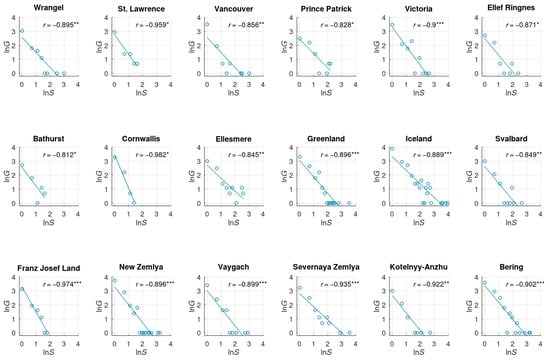
Figure 4.
Pearson correlation coefficients between the log-transformed number of genera (lnG) and the log-transformed number of species they contain (lnS), for the diatom floras of the studied islands. *, p < 0.05; **, p < 0.01; and ***, p < 0.001.
3.4. Species–Area Relationships for the Diatom Floras on the Studied Islands and Their Climatic Adjustment
To reveal the factors determining species richness of the diatom floras on the studied islands, we examined eight alternative SAR models: two baseline models relating species richness solely to area, and three extensions of each baseline model that incorporate the effects of climate-related factors (Table 2). In the baseline Arrhenius-type model, the island area emerged as a marginally significant predictor (p = 0.080), and the model demonstrated rather low overall fit (R2 = 0.191) (Table 4, model 1). The baseline Gleason-type model showed an even worse performance (R2 = 0.125), with the island area being insignificant (p = 0.164) (Table 4, model 5)

Table 4.
Parameter estimates and performance statistics of selected species–area relationship models.
Climatic extensions of both baseline models improved performance when the climate-related factors were introduced to modify the intercept. Among the tested climate-related factors, the CAFF region—defined by the severity of environmental conditions—enhanced model fit more effectively than latitude alone. Even more informative were remote MODIS-derived indices and several bioclimatic variables related to precipitation: BIO12 (annual precipitation), BIO14 (precipitation of driest month), BIO16 (precipitation of wettest quarter), BIO17 (precipitation of driest quarter), and especially BIO19 (precipitation of coldest quarter) (Figure 5). When BIO19 was used to modify the intercept, the log–log models achieved a remarkably high fit (R2 = 0.732; Table 4, model 2C), while the semi-log models performed even better (R2 = 0.833; Table 4, model 6C).
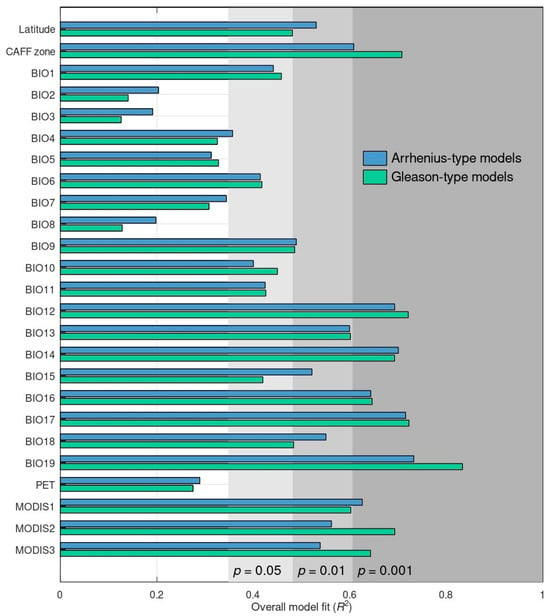
Figure 5.
Overall fit of species–area relationship models with the intercept modified by alternative climate-related factors. Grayscale shading shows R2 values corresponding to p < 0.05, p < 0.01, and p < 0.001 (based on the F statistics). All models were built for 17 islands within the CAFF region. The area of Greenland was reduced by the extent of the Greenland Ice Sheet.
At the same time, when the tested climate-related factors were incorporated to modify the slope—or both the intercept and the slope—the models’ overall fit improved, but at the expense of model stability. Specifically, some predictors (typically island area) became non-significant due to high covariation, while others reversed the direction of their effects. Such degenerated and unstable models are inappropriate for approximating species richness, despite their seemingly strong performance.
Thus, the two models that predict species richness most accurately are those in which BIO19 modifies the intercept of a baseline SAR model, either log–log or semi-log. The obtained coefficient estimates (Table 4, models 2C and 6C) yield the following equations for predicting species richness:
S = e2.695+0.168·lnA+0.007·BIO19 = 14.806e0.007·BIO19·A0.168
S = −205.727 + 26.266·lnA + 1.528·BIO19
These equations can be used to predict species richness on islands where the diatom flora remains insufficiently explored.
3.5. Diatom Diversity and Latitude
The distribution of total diatom diversity on the islands of the CAFF region is shown in Figure 6. Despite some fluctuation in species abundance from island to island, the trend line shows a tendency for species richness to increase with decreasing island latitude. It is also evident that the diatom communities of the High Arctic form a monolithic structure at high latitudes and then, with decreasing overall diversity, transition to the Low Arctic and Sub-Arctic zones of the CAFF.
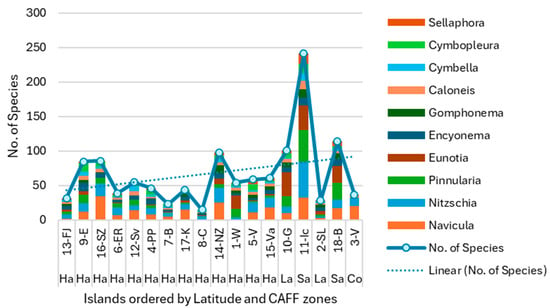
Figure 6.
Distribution of species richest genera of diatoms over the studied islands and CAFF region (Ha, High Arctic; La, Low Arctic; Sa, Sub-Arctic; Co, outside CAFF). Number of Islands as in Table 1. The studied islands are in order of decreasing latitude. Dashed line is the linear trend line for total species richness.
Generic diversity varies in the island floras from 27 to 136 in proportion to the total number of species, averaging 37 genera (Supplementary Table S3).
Figure 6 shows the dynamics of species numbers in the top 10 genera. The share of the first four genera in algal floras accounts for more than half of the species composition, increasing from 34 to 56% in the island floras with decreasing latitude. Also of interest is the dynamics of the Eunotia–Pinnularia species pair: their species participation in communities increases with decreasing latitude, while the Navicula–Nitzschia genera pair practically save the trend in its diversity over latitude. This may be a response to changing environmental parameters, including climate.
A statistical analysis of the similarity of the representation of the 10 leading genera from 42 in the floras of the studied islands is shown in Figure 7. Here, five cores of diversity can be distinguished, 1–3 of which represent the diversity of diatom genera of the High Arctic, cluster 4 includes genera from the High Arctic and non-Arctic regions, and cluster 5 represents a mixed group of floras from all three belts of the CAFF zone. Thus, diatom diversity adapts in a certain way to changing climatic parameters with decreasing latitude.
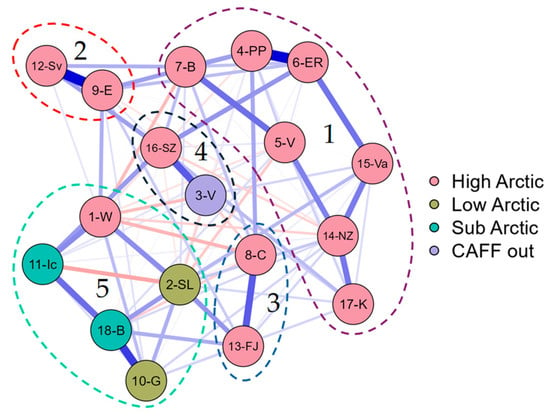
Figure 7.
JASP correlation network plot for the diatom flora of the studied islands, based on ten richest genera over CAFF zones. Abbreviation of islands as in Table 1 and CAFF out as outside CAFF. The line thickness represents the correlation strength, red lines are negative correlation, and blue lines are positive correlation. Clusters are outlined by dashed lines and numbered as 1–5.
The species most frequently found across all islands were Achnanthidium minutissimum (Kützing) Czarnecki (17 of studied islands), Diatoma tenuis C. Agardh (15 of studied islands), and Nitzschia perminuta Grunow (14 of studied islands).
3.6. Diatom Diversity and Threatened Categories of IUCN
All islands selected for the diversity dynamics analysis are protected areas. Therefore, it was particularly important to identify diatom species assigned to various IUCN conservation categories. Table 5 presents this distribution, showing that of the 1268 species, categories known for 386 species, of which 112 species belong to three categories, from Extinct to Endangered (Supplementary Table S3), accounting for only 8.8% of the total island flora studied. At the same time, IUCN category data are unknown for 944 species (Figure 8).

Table 5.
Distribution of diatom species from the 18 islands surveyed into threatened categories.
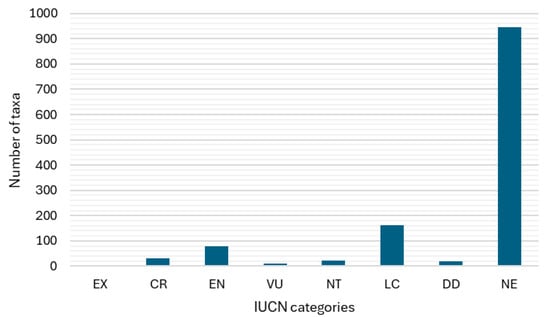
Figure 8.
Number of diatoms taxa in each of the threat categories of IUCN Red List. Threat categories: EX—Extinct or lost, CR—Critically endangered, EN—Endangered, VU—Vulnerable, NT—Near threatened, LC—Least concern, DD—Data deficient, and NE—Not evaluated.
Table 6 and Figure 9 represent distribution of diatom species of threat categories in the studied islands of the CAFF zones. It can be seen that the number of species of the first three categories (112) constitutes about 8.8% of the total species composition in the flora of each island and increases with decreasing latitude (Figure 9a,b) but the number of most threatened categories Ex and Cr on the version of IUCB sufficiently decreased (Figure 9c,d).

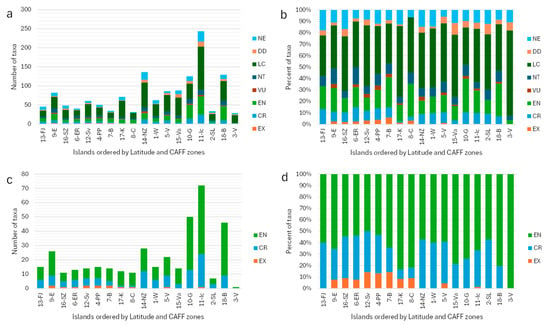
Figure 9.
Distribution of diatom species number over threat categories of IUCN Red List in the studied islands of the CAAF zone: (a), ratio, (b), percentage of species in threated categories; (c), ratio, (d), percentage of species in categories Extinct–Endangered. The code of each IUCN category corresponds to threat reduction with abbreviated names as in Table 5.
A cluster analysis of the diatom species composition of the first three IUCN categories is shown in Figure 10. The high level of threatened communities is highlighted by the division into clusters at a similarity level 70%, with the flora of threatened species on Vancouver Island, located outside the CAFF regions, positioned separately in cluster 1. Cluster 2 includes the floras of three large islands: Greenland, Iceland, and Bering. Cluster 3 includes the floras of threatened species on the remaining islands at similarity level 75%.
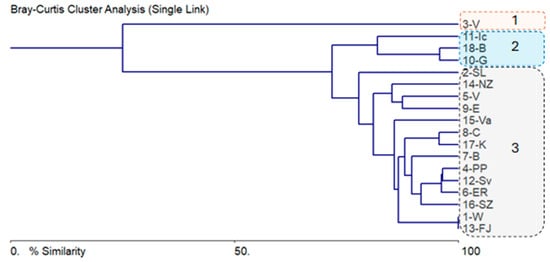
Figure 10.
Bray–Curtis similarity tree of sum of species from the IUCN Red List categories EX, CR, and EN in the diatom floras on the studied Arctic islands. Clusters outlined by dashed line.
At the same time, the JASCP cluster analysis reveals a high degree of individuality in the species composition of the islands (Figure 11a), allowing only two clusters to be identified as similar. The unique species confirm high individuality of the islands’ diatom floras and represent more than half of the total species list (714). Cluster 1 comprises diatoms from Novaya Zemlya and Vaygach islands in the Eurasian High Arctic, while cluster 2 includes three islands in the Canadian High Arctic. A different picture emerges when comparing the diversity of IUCN species categories 1-2-3 (Figure 11b). Here, the most closely related species in a single cluster are those from the High Arctic and the Low Arctic.

Figure 11.
JASP correlation network plots for the total species lists of diatoms (a) and sum of IUCN categories EX, CR, and EN only (b) for studied islands in CAFF regions and outside (CAFF out). The line thickness represents the correlation strength, red lines are negative correlation, and blue lines are positive correlation. Clusters are outlined by dashed lines and numbered as 1 and 2 on the figure (a) and outlined by a red dashed line on the figure (b).
A comparison of the species composition of diatoms shows not only the high individuality of the island floras (Figure 12a), but also a fairly high similarity in the species composition of the islands located near the coast of the continent (Figure 12b), that is, it reveals the geographical confinement of diversity.
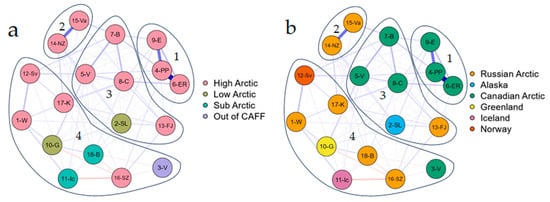
Figure 12.
JASP correlation network plots for distribution of total diatoms species (a) and sum of threatened categories EX, CR, and EN only (b) in the studied 18 islands of CAFF regions and outside (out of CAFF) (a) and the countries (b). The line thickness represents the correlation strength, red lines are negative correlation, and blue lines are positive correlation. Clusters are outlined by black lines and numbered.
3.7. Diatom Bioindicators over Island Latitude
The dynamics of indicator species in the communities of 18 studied diatom floras are shown in Figure 13, Figure 14 and Figure 15. The arrangement of indicator groups in descending order of island latitude allows us to analyze the latitudinal dynamics of the community’s ecological response and identify the main indicator groups experiencing optimal conditions. Figure 13a shows that benthic and planktonic–benthic species predominate, with the latter decreasing from pole to continent. Indicators of moderate temperature conditions predominate on all islands except Vancouver Island, outside the CAFF region, where the proportion of eurythermal species increases slightly (Figure 13b). The group of indicators of slow-flowing, moderately oxygenated waters predominates in all communities and increases with decreasing latitude (Figure 13c). Among the salinity indicator groups, the largest proportion is occupied by indifferent and halophobic species, the presence of which increases in the CAFF region with decreasing latitude, with the exception of Vancouver Island (Figure 13d).
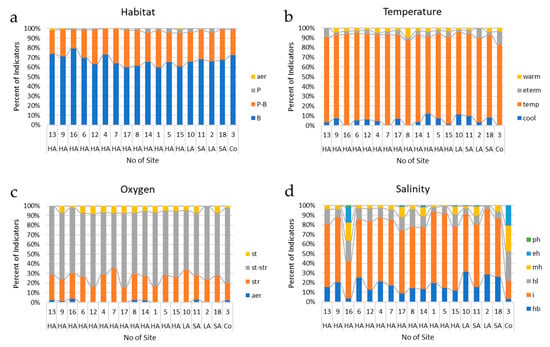
Figure 13.
Latitudinal distribution of the proportion of diatom indicator species on the studied islands: (a) Habitat, (b) Temperature; (c) Oxygen, and (d) Salinity. Indicator groups are abbreviated as in Supplementary Table S4.
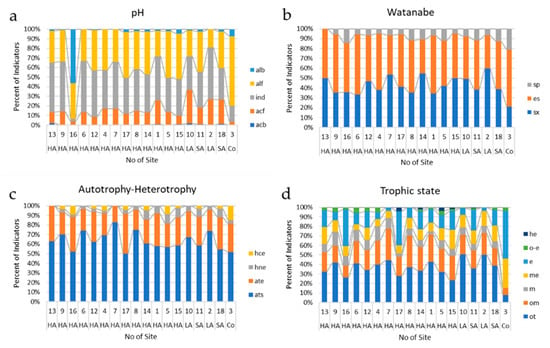
Figure 14.
Latitudinal distribution of the proportion of diatom indicator species on the studied islands: (a) pH, (b) Watanabe system; (c) Autotrophy–Heterotrophy, and (d) Trophic state. Indicator groups abbreviated as in Supplementary Table S4.
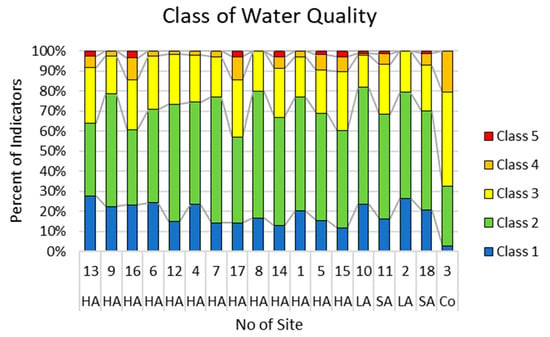
Figure 15.
Latitudinal distribution of the proportion of diatom indicator species of Class of Water Quality on the studied islands. Class of Water Quality represents the percentage of indicators with species-specific index saprobity S given in Supplementary Table S4.
Water pH indicator groups reveal a wide spectrum of the studied aquatic communities, with a tendency for the proportion of acidophilous to increase with decreasing latitude, except for Vancouver Island, outside the CAFF region, where the proportion of alkaliphilous is significant (Figure 14a). Organic pollution of waters according to the Watanabe system reveals a tendency to increase southward, with a significant proportion of saprophiles outside the CAFF region (Figure 14b). A similar trend is revealed by the distribution of nutritional group indicators, as the proportion of heterotrophic species outside the CAFF region amounts to 15% of the diatom community on Vancouver Island (Figure 14c). This is confirmed by the dynamics of trophic state groups, among which oligotrophs predominate, but the proportion of eutrophic water indicators increases to 50% outside the CAFF region (Figure 14d).
Indicators of water organic pollution classes in CAFF regions change in the same direction, with a general increase in the proportion of class I and II species with decreasing latitude. Interestingly, on Vancouver Island beyond the CAFF boundary, the sum of species of classes 3 and 4 is up to 70% (Figure 15).
To conclude the indicator species distribution analysis, we calculated the similarity of the sum of ecological parameters of species in the communities of each island and compared them across CAFF zones and in relation to the countries to which the islands belong (Figure 16). Figure 16a shows that the JASPC calculation allows us to identify five clusters, 1 and 2 of which are composed exclusively of High Arctic communities, cluster 3 also includes Sub-Arctic habitats, cluster 4 combines both Arctic habitats and islands outside of CAFF, and cluster 5 includes both the High Arctic and the Low Arctic. Thus, the influence of climatic factors on the ecological properties of the communities of the studied islands is less pronounced than the influence of specific environmental factors. Figure 16b shows indicator diatom communities for the studied islands across two continents, Eurasia and North America. Clusters 1 and 2 clearly include those most close to pole island communities from Norway and Arctic Canada. Clusters 3, 4, and 5 revealed the similarity of the circumpolar habitats of the Russian Arctic and Oceanic Canada. Thus, the analysis demonstrates the importance of the relationship of the studied islands to specific parts of the continents.
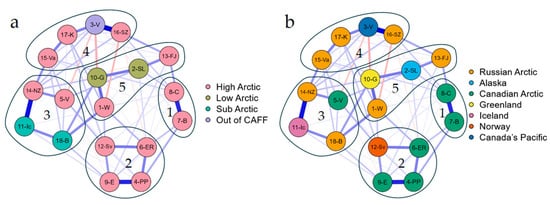
Figure 16.
JASP correlation network plots for distribution of diatoms indicators in the 18 islands studied over CAFF regions and outside (out of CAFF) (a) and the countries (b). The line thickness represents the correlation strength, red lines are negative correlation, and blue lines are positive correlation. Clusters are outlined by black lines and numbered. Calculation based on Supplementary Table S5 and Table 1.
4. Discussion
Studies of aquatic habitats demonstrate that gradients in water chemistry and lake productivity appear to be similar across habitats spanning the CAFF line, even across continents []. Basic geochemical and biological processes, such as nutrient transport, cycling, and use by primary producers, are likely common to circumpolar habitats. Trends in these processes likely reflect similar responses to climatic factors, with regional differences driven by differences in geological substrate, hydrology, or the degree of anthropogenic impact, which is minimal in the Arctic zone []. Information regarding the geographic distribution of diatom species is extremely limited. Existing concepts of species in the narrow sense, based on DNA structure and Vavilov’s species as a system, suggest two different approaches to biogeography. While the former describes species at points where cultures and DNA are identified, the latter is based more on morphological descriptions and the sum of habitat factors. However, in the modern taxonomic system, species from both concepts are equally accepted []. Thus, historically established references to species distributions are more closely related to morpho-ecological descriptions, some of which no longer reflect known habitats, since diatom genera are often divided into several newly described taxa based on molecular structure data. This difficulty in a generalized list of species in the algaebase.org [] translates into difficulties in the geographic analysis of the identified diversity. Under these conditions, studying patterns in the distribution of diatom diversity and their ecological responses to gradients of climatic factors is particularly relevant.
Our analysis demonstrated that species richness of the studied diatom floras of 18 islands of the CAFF region was strongly determined jointly by island area and several climate-related factors reflecting severity of environmental conditions. Notably, the baseline SAR models (i.e., those linking species richness exclusively to island area) showed rather low performance when applied to the examined data: area explained no more than 20% of the observed variation in species richness, and appeared as a marginally significant predictor in the Arrhenius-type model or even as a non-significant predictor in the Gleason-type model (see Table 4). This finding matches the results of a similar-scale (18 islands) analysis performed by Jamoneau et al. []: there, a significant effect of area on species richness of stream benthic diatoms was reported only on the mainland but not on islands []. At the same time, in their global analysis of vascular floras diversity across 488 islands, Kreft et al. [] reported a considerably stronger effect of island area, which in similar setups (namely, Arrhenius-type models without spatial autocorrelation) explained up to 50% of the observed variation in species richness []. This discrepancy could arise from several important differences in study design, e.g., a much lower sample size in our case (17 islands within the CAFF region versus 488 islands examined worldwide) or restrictedness to a specific taxon (only diatoms versus entire vascular plants). The relatively weak association with island area, observed both here and in [], can also be ascribed to a specific feature of diatoms, whose worldwide species pool is distinct so that species compositions across islands overlap insufficiently to capture the effect of area [].
However, the relatively weak association between species richness and island area revealed in our analysis (and also in that of []) may, at least partially, reflect a deeper pattern—a reallocation of explanatory power from area to environmental factors with increasing climatic extremes. In our study, climatic adjustment of the baseline SAR models drastically increased their fit: from less than 20% to 73% in the Arrhenius-type model, and even to 83% in the Gleason-type model (see Table 4)—opposite to the findings of the global survey by Kreft et al., where area emerged as the main predictor and climatic variables only further enhanced the model []. The assumption of such a reallocation seems plausible given that the overall fit of the climate-adjusted SAR models in the two studies (ours and that of []) was quite similar, at about 70–80%. The importance of climate-related factors revealed in our analysis corroborates the long-standing view that environmental conditions should affect SAR [,,]. Expectedly, latitude—a simple and rough proxy of environmental severity—enhanced the baseline SAR models less than did the CAFF region, explicitly defined based on climatic conditions (to 48–53% and 61–71% of the explained variation, respectively—see Table 4). Accordingly, the most powerful climate-related predictor in our analysis was BIO19—precipitation of the coldest quarter (see Figure 5). Remarkably, the key role of BIO19 has been repeatedly reported for various plant species [,,]. These findings corroborate the conclusion of Kreft et al. that precipitation and temperature are the two main climatic determinants of species richness, with approximately equal significance [], and reflect the idea that complex climatic extremes (as BIO19 incorporates both temperature and precipitation) act as stronger limiting factors.
An interesting outcome of our analysis is the very small difference between the two classical types of SAR models, Arrhenius and Gleason. The comparison of these types and the scope of their applicability have long been discussed in the biogeographical literature [,,]. A general, simplified conclusion is that Gleason-type models better suit low-range datasets and homogeneous environments with contiguous sampling and considerable spatial autocorrelation. Our results indeed show a slightly higher model fit for the Gleason-type models, which generally aligns with this conclusion, given the homogeneity of water habitats. Yet, the difference is minor, supporting the idea that the two types of SAR models may sometimes converge quite closely, thereby justifying hybrid or intermediate functions [].
Further improvement of the obtained SAR models is possible by accounting for several other important factors overlooked at this stage. Probably the most potent effects may come from islands’ long-term geological history. For example, glaciation-associated sea-level changes may have substantially affected island areas per se, their isolation and connectivity, and consequently, rates of species immigration and extinction [,]. Additionally, the models could account for anthropogenic pressures such as contamination, which can modify dispersal patterns in a species-specific way, favoring eurybiontic and xenobiotic-tolerant taxa at the expense of Arctic specialists []. Yet, including additional predictors requires a much larger sample size and, consequently, acquisition of data on diatom diversity from other islands.
Our analysis of a diatom diversity database of 1268 species from 18 Arctic islands in the CAFF region, compiled from our own and published studies, demonstrated the applicability of systems analysis methods to the selected floras and developed a model for assessing the representativeness of species composition. A consistent pattern of change was demonstrated, and the main influencing macroclimatic parameters were identified, including BIO19 (precipitation of the coldest quarter) and MODIS Dynamic Habitat Indices (DHI). This is the first study of the influence of macroclimatic factors on the distribution of diversity and ecological confinement properties of diatoms, although some similar attempts have been made previously when communities at the margins of the continent were recognized as a hotspot for algal biodiversity []. The distribution of community diversity by habitat latitude showed a trend toward increasing species richness toward the south. The Eunotia–Pinnularia species pair increased to the south, while the Navicula–Nitzschia genera pair, conversely, decreased, which may indicate a response to changing environmental parameters, including climate. Previously, our attention was drawn to the distribution of the Eunotia–Pinnularia pair and an increase in the role of Pinnularia in protected areas and large floras [,] was revealed, and Eunotia with a decrease in water pH []. The significant number of arctic–alpine and endemic species in the studied communities (Supplementary Tables S4 and S5), which is evident in protected areas, is not surprising. However, for the environmental variables for which diatoms are excellent bioindicators [], patterns in latitudinal distribution become apparent such as an increase in diversity of the acidophilous group, indicators of saline waters, and organic pollution from north to south, toward the continents.
Geographic isolation can be an important factor in maintaining diatom biodiversity []. The distribution of diatoms across various islands of the world’s oceans and adjacent parts of continents revealed the influence of island isolation, which leads to increased individuality of species composition []. The high diversity of diatom species composition on 18 Arctic islands has its own reasons, and not because this diversity is specific to polar regions, such as Antarctic surface water communities. It is clear that both polar regions, alongside cosmopolitan species, also contain polar inhabitants [,,]. Our study shows that high community diversity and individuality is characteristic of virtually all island communities, but similarities in species composition are evident across both diametrically opposed islands and continental margins, with the largest number of island communities forming circumpolar clades. This points to the properties of macroclimatic parameters, which influence the formation of diatom communities in the surface waters of the CAFF region more than local factors.
It was also possible to calculate indices reflecting intraspecific variability [], which varied within the range of 1.0–1.10 and tended to increase at high latitudes (Figure 3). Conversely, the index of the number of species per unit of island area increased, concurrently with increases in species richness, BIO temperature [], and MODIS DHI (Dynamic Habitat Indices) indices, revealing the importance of climatic parameters in the formation and development of diatom species richness, a first for this purpose.
The importance of assessing the vulnerability of Arctic biodiversity was revealed by an analysis of the distribution of threatened species by IUCN categories []. There is no global Red Data Book of diatoms. Regional lists are being created, but microalgae are either not included or only partially mentioned. There is no Red Data Book of Arctic microalgae, and this work can only serve as a first step in this direction. Therefore, we drew on known regional resources. These are the ones where species are considered to have abandoned or are threatened in the area for which the IUCN criteria were applied. Therefore, we used the existing resource of regional Red Data Books for microalgae to take the first step toward creating a Red Data Book of Arctic microalgae and attempt to use a single resource to assess the potential dynamics of threatened species in relation to general climatic factors. Although we adhere to the concept of a cosmopolitan distribution of microalgae, particularly diatoms, we cannot edit the original resources cited in this section for regional information. Despite this, species such as Cymbopleura designata (Krammer) Bahls or Encyonema latens (Krasske) D.G. Mann mentioned in [] are assessed regionally as belonging to the EX category, or, for example, Psammothidium kryophilum (J.B. Petersen) E.Reichardt, Eunotia flexuosa (Brébisson ex Kützing) Kützing, and others to the CR category; these species, according to the well-organized, informative, and quickly updated resource [], are widespread or, at least, Holarctic. We do not consider the data on the IUCN categories for the identified diatom species given in Supplementary Table S3 to be some kind of guide for use, or even a basis for creating a future Red Data Book of Arctic diatoms, but only a tool for the first step in this direction. Thus, in connection with their cosmopolitan distribution, the importance of diatom species as bioindicators of the conditions in which they are found increases even more.
Until now, such an assessment had rarely been conducted for islands but revealed that in geographically isolated habitats such as islands, the proportions of diatom diversity and rare species diversity are correlated [], which we can see in our analysis. In the Arctic, for the Lena Delta Nature Reserve and adjacent territories, it was found that approximately half of the diatom species diversity can be used to assess the vulnerability of Arctic aquatic habitat communities []. For Arctic islands communities, it was possible to identify a trend toward an increase in the proportion of vulnerable species moving southward, most notably among the Critically Endangered species category. This makes it possible to use the vulnerability factor to monitor changes in communities under the influence of changing environmental factors. So, coexistence of species requires differences in niches, and harshness per se does not make coexistence more likely, but harsh and variable conditions play an important role in maintaining diversity [].
5. Conclusions
The distribution of 1268 species altogether of diatom algae from 18 Arctic islands in the CAFF region were analyzed by methods of bioindication and statistics. A model for assessing diversity representativeness for adequate analysis was developed, which can be applied to subsequent studies of algal floras. Analysis of diatom diversity and climatic factors relationships revealed temperature and precipitation as strongest limiting factors that influenced community of waterbodies of islands in CAFF region. Diatom diversity in islands shows high individuality of species content. More than a third of the diatom species listed in 18 islands investigated in CAFF region (324 species) have IUCN categories according a known resource of which 112 species belong to three most threatened (EX, CR, and EN), and the species number of which increased towards the south. However, 944 species have not been evaluated yet, which shows the possibility of creating a Red Data Book of Arctic diatoms in the future. The most threatened or endangered categories are species from the High Arctic and the Low Arctic. At the same time, the number of species not assessed increases with decreasing latitude of habitat. The latitudinal dynamics of bioindicators demonstrated the ecological response of diatom communities to climate factors and helps to identify the main indicator groups experiencing optimal conditions. So, islands’ diatom species prefer benthic and planktonic–benthic habitats, well-oxygenated waters with low salinity, and moderate temperature conditions predominate on all islands except Vancouver Island, outside the CAFF region. Bioindicator analysis revealed an increase in the number of species, indicating water pH, organic matter, and eutrophy and mixotrophy towards the south, which correlated with increasing temperature and ecological indices values. Comparison of total indicator content of island diatoms demonstrates the importance of the relationship of the studied islands to specific parts of the continents such as east side of Eurasia and North America, diametrically opposed countries such as Arctic Russia and Arctic Canada, or circumpolar distribution.
Supplementary Materials
The following supporting information can be downloaded at https://www.mdpi.com/article/10.3390/d17120808/s1; Table S1: Environmental variables for assessment of climate influence to biodiversity of diatoms of the Arctic islands in the CAFF region according to [,]; Table S2: MODIS Dynamic Habitat Indices in the studied 18 islands and CAFF zones according to []; Table S3: Diatoms species list for the Arctic islands on the CAAF region with the Red Book and IUCN categories and arctic islands distribution; Table S4: Ecological properties of diatoms species of the Arctic islands on the CAAF region; Table S5: Diatom ecological indicators and diversity characteristics distribution over 18 islands of CAFF.
Author Contributions
Conceptualization, S.B. and V.A.G.; methodology, S.R.R. and S.B.; software, S.B. and S.R.R.; validation, S.B. and V.A.G.; formal analysis, S.B. and S.R.R.; investigation, S.B. and V.A.G.; resources, V.A.G.; data curation, S.B.; writing—original draft preparation, V.A.G., S.B. and S.R.R.; writing—review and editing, S.R.R., S.B. and V.A.G.; GIS data preparation, B.B. and V.A.G.; visualization, S.B. and S.R.R.; supervision, V.A.G.; project administration, V.A.G.; funding acquisition, V.A.G. and S.B. All authors have read and agreed to the published version of the manuscript.
Funding
This research was carried out within the state assignment of the Ministry of Science and Higher Education of the Russian Federation (theme No. FWRS-2021-0023, reg. No. AAAA-A21-121012190038-0).
Institutional Review Board Statement
Not applicable.
Data Availability Statement
The original contributions presented in this study are included in the article/Supplementary Material. Further inquiries can be downloaded or request from the authors.
Acknowledgments
We are grateful to the Israeli Ministry of Aliyah and Integration for partial support of this work.
Conflicts of Interest
The authors declare no conflicts of interest.
Abbreviations
The following abbreviations are used in this manuscript:
| JASP | Jeffreys’s Amazing Statistics Program |
| IUCN | International Union for Conservation of Nature and Natural Resources |
| MODIS | Moderate Resolution Imaging Spectroradiometer |
| DHI | Dynamic Habitat Indices |
| PET | Potential evapotranspiration |
| CAFF | Conservation of Arctic Flora and Fauna |
| SAR | Species–area relationship |
References
- Knights, D.; Piliouras, A.; Schwenk, J.; Hariharan, J.; Russoniello, C. Seasonal and morphological controls on nitrate retention in Arctic deltas. Geophys. Res. Lett. 2023, 50, e2022GL102201. [Google Scholar] [CrossRef]
- Jeppesen, E.; Brucet, S.; Naselli-Flores, L.; Papastergiadou, E.; Stefanidis, K.; Nõges, T.; Nõges, P.; Attayde, J.L.; Zohary, T.; Coppens, J.; et al. Ecological impacts of global warming and water abstraction on lakes and reservoirs due to changes in water level and related changes in salinity. Hydrobiologia 2015, 750, 201–227. [Google Scholar] [CrossRef]
- Lugg, A.; Copeland, C. Review of cold water pollution in the Murray–Darling Basin and the impacts on fish communities. Ecol. Manag. Restor. 2014, 15, 71–79. [Google Scholar] [CrossRef]
- Arctic Biodiversity Assessment. Available online: https://www.arcticbiodiversity.is/ (accessed on 1 October 2025).
- Safeguarding Arctic Biodiversity. Available online: https://arctic-council.org/explore/topics/biodiversity/ (accessed on 10 October 2025).
- Duff, K.E.; Laing, T.E.; Smol, J.P.; Lean, D.R.S. Limnological characteristics of lakes located across arctic treeline in northern Russia. Hydrobiologia 1998, 391, 203–220. [Google Scholar] [CrossRef]
- Polyakov, I.V.; Alexeev, V.A.; Belchansky, G.I.; Dmitrenko, I.A.; Ivanov, V.V.; Kirillov, S.A.; Korablev, A.A.; Steele, M.; Timokhov, L.A.; Yashayaev, I. Arctic Ocean Freshwater Changes over the Past 100 Years and Their Causes. J. Clim. 2008, 21, 364–384. [Google Scholar] [CrossRef]
- Prowse, T.D.; Wrona, F.J.; Reist, J.D.; Hobbie, J.E.; Lévesque, L.M.J.; Vincent, W.F. General Features of the Arctic Relevant to Climate Change in Freshwater Ecosystems. Ambio 2006, 35, 330–338. [Google Scholar] [CrossRef] [PubMed]
- Albert, R.-L.; Korhola, A.; Sorvari, S. Analysis of factors controlling epilithic diatom community compositions in subarctic lakes of Finnish Lapland. Adv. Limnol. 2009, 62, 125–151. [Google Scholar] [CrossRef]
- Wehr, J.D.; Sheath, R.G.; Kociolek, J.P. Freshwater Algae of North America: Ecology and Classification, 2nd ed.; AcademicPress: San Diego, CA, USA, 2013; p. 1050. [Google Scholar]
- Bellinger, E.G.; Sigee, D.C. Freshwater Algae: Identification and Use as Bioindicators; John Wiley & Sons: Chichester, UK, 2015; p. 284. [Google Scholar]
- Battarbee, R.W. Diatom analysis. In Handbook of Holocene Palaeoecology and Palaeohydrology; Wiley: Chichester, UK, 1986; pp. 527–570. [Google Scholar]
- Culp, J.M.; Lento, J.; Goedkoop, W.; Power, M.; Rautio, M.; Christoffersen, K.S.; Guðbergsson, G.; Lau, D.; Liljaniemi, P.; Sandøy, S.; et al. Developing a circumpolar monitoring framework for Arctic freshwater biodiversity. Biodiversity 2012, 13, 215–227. [Google Scholar] [CrossRef]
- Flower, R.J.; Kernan, M.; Noon, P.E.; Jones, V.J. On the factors affecting distributions of freshwater diatom species in a remote South Atlantic archipelago. Eur. J. Phycol. 2012, 47, 291–309. [Google Scholar] [CrossRef]
- Christensen, T.; Payne, J.F.; Schmidt, N.M.; Madsen, J.; Taylor, J.J.; Doyle, M.; Gill, M.; Nymand, J.; Svoboda, M.; Rosa, C.; et al. Terrestrial Expert Monitoring Plan—Background Paper; A Supporting Publication to the CBMP Framework Document. CAFF Monitoring Series Report; CAFF International Secretariat: Akureyri, Iceland, 2011; Nr. 6; ISBN 978-9935-431-11-0. [Google Scholar]
- Lento, J.; Goedkoop, W.; Culp, J.; Christoffersen, K.S.; Larusson, K.F.; Fefilova, E.; Gudbergsson, G.; Liljaniemi, P.; Olafsson, J.S.; Sandoy, S.; et al. State of the Arctic Freshwater Biodiversity; Conservation of Arctic Flora and Fauna International Secretariat: Akureyri, Iceland, 2019; Available online: https://www.caff.is/freshwater/freshwater-monitoring-publications/488-state-of-the-arctic-freshwater-biodiversity-report-full-report (accessed on 6 October 2023).
- Foged, N. Diatoms in Alaska. In Bibliotheca Phycologica; Cramer, J., Ed.; Gebrüder Borntraeger Verlagsbuchhandlung (Nägele u.Obermiller): Stuttgart, Germany, 1981; Band 53; pp. 1–317. [Google Scholar]
- Kharitonov, V.G. Diatoms of the benthic water bodies of the Wrangel Island. Novit. Syst. Plant. Non Vasc. 1981, 18, 33–39. (In Russian) [Google Scholar]
- Hobbie, J.E.; Peterson, B.J.; Bettez, N.; Deegan, L.; O’Brien, W.J.; Kling, G.W.; Kipphut, G.W.; Bowden, W.B.; Hershey, A.E. Impact of global change on the biogeochemistry and ecology of an Arctic freshwater system. Polar Res. 1999, 18, 207–214. [Google Scholar] [CrossRef]
- Kendrick, M.R.; Huryn, A.D.; Bowden, W.B.; Deegan, L.A.; Findlay, R.H.; Hershey, A.E.; Peterson, B.J.; Beneš, J.P.; Schuett, E.B. Linking permafrost thaw to shifting biogeochemistry and food web resources in an arctic river. Glob. Change Biol. 2018, 24, 5738–5750. [Google Scholar] [CrossRef]
- Barinova, S.S. An assessment of the state of aquatic ecosystems of Novaya Zemlya Archipelago (Novozemelskiy reserve, Russia). Int. J. Algae 2000, 2, 62–69. [Google Scholar] [CrossRef]
- Barinova, S.; Gabyshev, V. The Influence of Arctic Conditions on the Formation of Algae and Cyanobacteria Diversity and on the Water Quality of Freshwater Habitats on Kotelny Island, Lena Delta Wildlife Reserve, Yakutia. Water 2024, 16, 1231. [Google Scholar] [CrossRef]
- Genkal, S.I.; Gabyshev, V.A. Diatom algae (Bacillariophyta) in waterbodies and watercourses on Kotelny Island (New Siberian Islands Archipelago). Bot. Zhurnal 2020, 105, 750–761. (In Russian) [Google Scholar] [CrossRef]
- Antoniades, D.; Douglas, M.S.V. Characterization of high arctic stream diatom assemblages from Cornwallis Island, Nunavut, Canada. Can. J. Bot. 2002, 80, 50–58. [Google Scholar] [CrossRef]
- Antoniades, D.; Douglas, M.S.V.; Smol, J.P. Benthic diatom autecology and inference model development from the Canadian High Arctic Archipelago. J. Phycol. 2005, 41, 30–45. [Google Scholar] [CrossRef]
- Antoniades, D.; Hamilton, P.B.; Douglas, M.S.; Smol, J.P. Diatoms of North America: The Freshwater Floras of Prince Patrick, Ellef Ringnes and Northern Ellesmere Islands from the Canadian Arctic Archipelago; A.R.G. Gantner Verlag K.G.: Ruggell, Liechtenstein, 2008; p. 649. [Google Scholar]
- Bahls, L. Diatoms of Montana and Western North America: Catalog and Atlas of Species in the Montana Diatom Collection; Academy of Natural Sciences of Philadelphia Special Publication: Philadelphia, PA, USA, 2021; Volume 1, pp. 1–508. [Google Scholar]
- Bahls, L.; Luna, T. Diatoms from Wrangell-St. Elias National Park, Alaska, USA. PhytoKeys 2018, 113, 33–57. [Google Scholar] [CrossRef] [PubMed]
- Bouchard, G.; Gajewski, K.; Hamilton, P.B. Freshwater Diatom Biogeography in the Canadian Arctic Archipelago. J. Biogeogr. 2004, 31, 1955–1973. [Google Scholar] [CrossRef]
- Sawai, Y.; Tanigawa, K.; Shinozaki, T.; Bobrowsky, P.T.; Huntley, D.; Goff, J. Diatom (Bacillariophyceae) assemblages in tidal environments of Vancouver Island, British Columbia, Canada. Phycol. Res. 2021, 70, 3–21. [Google Scholar] [CrossRef]
- Douglas, M.S.V.; Hamilton, P.B.; Pienitz, R.; Smol, J.P. Algal indicators of environmental change in Arctic and Antarctic lakes and ponds. In Long-Term Environmental Change in Arctic and Antarctic Lakes; Pienitz, R., Douglas, M.S.V., Smol, J.P., Eds.; Kluwer Academic Publishers: Dordrecht, The Netherlands, 2004; pp. 117–157. [Google Scholar]
- Douglas, M.S.V.; Smol, J.P. Freshwater diatoms from high arctic ponds (Cape Herschel, Ellesmere Island, N.W.T.). Nova Hedwig. 1993, 57, 511–552. [Google Scholar]
- Douglas, M.S.V.; Smol, J.P. Freshwater diatoms as indicators of environmental change in the High Arctic. In The Diatoms: Applications for the Environmental and Earth Sciences, 2nd ed.; Smol, J.P., Stoermer, E.F., Eds.; Cambridge University Press: Cambridge, UK, 2010; Part 13; pp. 249–266. [Google Scholar]
- Genkal, S.I.; Vekhov, N.V. Diatoms of Water Bodies of the Russian Arctic: Novaya Zemlya Archipelago and Vaigach Island; Nauka: Moscow, Russia, 2007; pp. 1–59. (In Russian) [Google Scholar]
- Hallgrímsson, H. Algae Census: List of Aquatic and Terrestrial Algae in Iceland According to Sources; Natturufrædistofnun Islands: Reykjavík, Iceland, 2008; p. 96. (In Icelandic) [Google Scholar]
- Kim, G.H.; Klochkova, T.A.; Han, J.W.; Kang, S.-H.; Choi, H.G.; Chung, K.W.; Kim, S.J. Freshwater and Terrestrial Algae from Ny-Ålesund and Blomstrandhalvøya Island (Svalbard). Arctic 2011, 64, 25–31. [Google Scholar] [CrossRef]
- Krasheninnikov, A.B.; Gavrilo, M.V.; Elkin, A.A.; Moseev, D.S.; Kaigorodov, R.V.; Toropov, L.I. Features of freshwater ecosystems of the Franz Josef Land archipelago. Polar Sci. 2022, 33, 100849. [Google Scholar] [CrossRef]
- Lim, D.; Douglas, M.; Smol, J. Diatoms and their relationship to environmental variables from lakes and ponds on Bathurst Island, Nunavut, Canadian High Arctic. Hydrobiologia 2001, 450, 215–230. [Google Scholar] [CrossRef]
- Manolaki, P.; Wu, N.; Mattesen, E.; Pastor, A.; Riis, T. Benthic diatom communities in high-Arctic streams across a water chemistry gradient in Zackenberg Valley, Northeast Greenland. Polar Biol. 2024, 47, 1559–1574. [Google Scholar] [CrossRef]
- Matveyeva, N.V.; Zanokha, L.L.; Afonina, O.M.; Potemkin, A.D.; Patova, E.N.; Davydov, D.A.; Andreeva, V.M.; Zhurbenko, M.P.; Konoreva, L.A.; Zmitrovich, I.V.; et al. Plants and Fungi of the Polar Deserts in the Northern Hemisphere; Marafon: St. Petersburg, Russia, 2015; p. 320. (In Russian) [Google Scholar]
- Michelutti, N.; Holtham, A.J.; Douglas, M.S.V.; Smol, J.P. Periphytic diatom assemblages from ultra-oligotrophic and uv transparent lakes and ponds on Victoria Island and comparisons with other diatom surveys in the Canadian Arctic. J. Phycol. 2003, 39, 465–480. [Google Scholar] [CrossRef]
- Michelutti, N.; McCleary, K.; Douglas, M.S.; Smol, J.P. Comparison of Freshwater Diatom Assemblages from a High Arctic Oasis to Nearby Polar Desert Sites and Their Application to Environmental Inference Models. J. Phycol. 2013, 49, 41–53. [Google Scholar] [CrossRef] [PubMed]
- Hallgrímsson, H. Þörungatal: Skrá yfir vatna- og landþörunga á Íslandi samkaemt heimildum [Algae census: List of aquatic and terrestrial algae in Iceland according to sources]. Fjölrit Náttúrufrædistofnunar Natturufrædistofnun Isl. Reykjavík 2007, 48, 1–94. [Google Scholar]
- Perren, B.B.; Bradley, R.S.; Francus, P. Rapid Lacustrine Response to Recent High Arctic Warming: A Diatom Record from Sawtooth Lake, Ellesmere Island, Nunavut. Arct. Antarct. Alp. Res. 2003, 35, 271–278. [Google Scholar] [CrossRef]
- Picińska-Fałtynowicz, J. Freshwater benthic diatoms from the south-western part of the Hornsund fiord area, SW Spitsbergen. Polar Res. 1988, 6, 19–34. [Google Scholar] [CrossRef]
- Pla-Rabés, S.; Hamilton, P.B.; Ballesteros, E.; Gavrilo, M.; Friedlander, A.M.; Sala, E. The structure and diversity of freshwater diatom assemblages from Franz Josef Land Archipelago: A northern outpost for freshwater diatoms. PeerJ 2016, 4, e1705. [Google Scholar] [CrossRef] [PubMed]
- Podritske, B.; Gajewski, K. Diatom community response to multiple scales of Holocene climate variability in a small lake on Victoria Island, NWT, Canada. Quat. Sci. Rev. 2007, 26, 3179–3196. [Google Scholar] [CrossRef]
- Potapova, M. Diatoms of Bering Island, Kamchatka, Russia. Nova Hedwig. 2014, 143, 63–102. [Google Scholar]
- Rampone, J. Diatoms as Indicators of Climate Change on St. Lawrence Island, Alaska. Bachelor’s Thesis, Queen’s University, Kingston, ON, Canada, 28 April 2015. [Google Scholar]
- Sapozhnikov, P.V.; Kalinina, O.Y.; Snigirova, A.A. Modern benthic diatom taxocenes of loose grounds of the coast of the Severnaya Zemlya archipelago and adjacent sea areas. Issues Mod. Algol. 2020, 3, 1–18. [Google Scholar] [CrossRef]
- Skulberg, O.M. Terrestrial and limnic algae and cyanobacteria. In A Catalogue of Svalbard Plants, Fungi, Algae and Cyanobacteria; Elvebakk, A., Prestrud, P., Eds.; Norwegian Polar Institute: Oslo, Norway, 1996; Part 9; pp. 383–395. [Google Scholar]
- Smol, J.P.; Stoermer, E.F. The Diatoms: Applications for the Environmental and Earth Sciences, 2nd ed.; Cambridge University Press: Cambridge, UK, 2010; p. 686. [Google Scholar]
- Van De Vijver, B.; Van Kerckvoorde, A.; Beyens, L. Freshwater and terrestrial moss diatom assemblages of the Cambridge Bay area, Victoria Island (Nunavut, Canada). Nova Hedwig. 2003, 76, 225–243. [Google Scholar] [CrossRef]
- Weckström, K.; Weckström, J.; Wischnewski, J.; Davidson, T.A.; Lauridsen, T.L.; Landkildehus, F.; Christoffersen, K.S.; Jeppesen, E. Unlocking environmental archives in the Arctic—Insights from modern diatom-environment relationships in lakes and ponds across Greenland. Front. Ecol. Evol. 2023, 11, 1177638. [Google Scholar] [CrossRef]
- Guiry, M.D.; Guiry, G.M. AlgaeBase. World-Wide Electronic Publication, University of Galway. Available online: https://www.algaebase.org (accessed on 3 March 2025).
- Fick, S.E.; Hijmans, R.J. WorldClim 2: New 1-km spatial resolution climate surfaces for global land areas. Int. J. Climatol. 2017, 37, 4302–4315. [Google Scholar] [CrossRef]
- Myneni, R.; Knyazikhin, Y.; Park, T. MOD15A2H MODIS Leaf Area Index/FPAR 8-Day L4 Global 500m SIN Grid V006; NASA EOSDIS Land Processes DAAC: Sioux Falls, SD, USA, 2015. [Google Scholar] [CrossRef]
- Zomer, R.J.; Xu, J.; Trabucco, A. Version 3 of the Global Aridity Index and Potential Evapotranspiration Database. Sci. Data 2022, 9, 409. [Google Scholar] [CrossRef]
- Willis, J.C. Age and Area. A study in Geographical Distribution and Origin of Species; Cambridge University Press: Cambridge, UK, 1922; p. 259. [Google Scholar]
- Barinova, S. Systemic Criteria for the Analysis of Alpha- and Gamma-Diversity of Freshwater Algae. Int. J. Environ. Sci. Nat. Resour. 2017, 4, 555633. [Google Scholar] [CrossRef]
- JASP Team. JASP, Version 0.18.3; [Computer software]; JASP Team: Amsterdam, The Nederland, 2024. Available online: https://jasp-stats.org/ (accessed on 6 October 2023).
- Arrhenius, O. Species and area. J. Ecol. 1921, 9, 95–99. [Google Scholar] [CrossRef]
- MacArthur, R.H.; Wilson, E.O. An equilibrium theory of insular zoogeography. Evolution 1963, 17, 373–387. [Google Scholar] [CrossRef]
- MacArthur, R.H.; Wilson, E.O. The Theory of Island Biogeography; Princeton University Press: Princeton, NJ, USA, 1967; p. 203. [Google Scholar]
- Gleason, H.A. On the relation between species and area. Ecology 1922, 3, 158–162. [Google Scholar] [CrossRef]
- Barinova, S. Database of Ecological Indicators of Freshwater Algae and Cyanobacteria. Ecol. Divers. 2025, 2, 10003. [Google Scholar] [CrossRef]
- McAleece, N.; Gage, J.D.G.; Lambshead, P.J.D.; Paterson, G.L.J. BioDiversity Professional Statistics Analysis Software; Scottish Association for Marine Science: Oban, UK; Natural History Museum London: London, UK, 1997; Available online: https://www.sams.ac.uk/science/outputs/ (accessed on 6 October 2023).
- Wessa, P. Person Correlation (v1.0.13) in Free Statistics Software; v1.2.1. Office for Research Development and Education: Singapore, 2017. Available online: https://www.wessa.net/rwasp_correlation.wasp/ (accessed on 23 December 2024).
- Hofmann, G.; Lange-Bertalot, H.; Werum, M.; Klee, R. Rote Liste und Gesamtartenliste der limnischen Kieselalgen (Bacillariophyta) Deutschlands. In Rote Liste der gefährdeten Tiere, Pflanzen und Pilze Deutschlands; Band 7: Pflanzen; Naturschutz und Biologische Vielfalt; Bundesamt für Naturschutz: Bonn, Germany, 2018; Volume 70, pp. 601–708. [Google Scholar]
- IUCN. IUCN Red List Categories and Criteria, Version 3.1, 2nd ed.; IUCN: Gland, Switzerland; Cambridge, UK, 2012; pp. 1–32.
- Love, J.; Selker, R.; Marsman, M.; Jamil, T.; Dropmann, D.; Verhagen, J.A.; Ly, A.; Gronau, F.Q.; Smira, M.; Epskamp, S.; et al. JASP: Graphical statistical software for common statistical designs. J. Stat. Softw. 2019, 88, 1–17. [Google Scholar] [CrossRef]
- Jamoneau, A.; Soininen, J.; Tison-Rosebery, J.; Boutry, S.; Budnick, W.R.; He, S.; Marquié, J.; Jyrkänkallio-Mikkola, J.; Pajunen, V.; Teittinen, A.; et al. Stream diatom biodiversity in islands and continents—A global perspective on effects of area, isolation and environment. J. Biogeogr. 2022, 49, 2156–2168. [Google Scholar] [CrossRef]
- Kreft, H.; Jetz, W.; Mutke, J.; Kier, G.; Barthlott, W. Global diversity of island floras from a macroecological perspective. Ecol. Lett. 2008, 11, 116–127. [Google Scholar] [CrossRef] [PubMed]
- Soininen, J.; Jamoneau, A.; Rosebery, J.; Passy, S.I. Global patterns and drivers of species and trait composition in diatoms. Glob. Ecol. Biogeogr. 2016, 25, 940–950. [Google Scholar] [CrossRef]
- Connor, E.F.; McCoy, E.D. The statistics and biology of the species-area relationship. Am. Nat. 1979, 113, 791–833. [Google Scholar] [CrossRef]
- Rosenzweig, M.L. Species Diversity in Space and Time; Cambridge University Press: Cambridge, UK, 1995; p. 436. [Google Scholar]
- Whittaker, R.J.; Fernández-Palacios, J.M. Island Biogeography, 2nd ed.; Oxford University Press: Oxford, UK, 2007; p. 401. [Google Scholar]
- Gebrewahid, Y.; Abrehe, S.; Meresa, E.; Eyasu, G.; Abay, K.; Gebreab, G.; Kidanemariam, K.; Adissu, G.; Abreha, G.; Darcha, G. Current and future predicting potential areas of Oxytenanthera abyssinica (A. Richard) using MaxEnt model under climate change in Northern Ethiopia. Ecol. Process. 2020, 9, 6. [Google Scholar] [CrossRef]
- Gao, X.; Lin, F.; Li, M.; Mei, Y.; Li, Y.; Bai, Y.; He, X.; Zheng, Y. Prediction of the potential distribution of a raspberry (Rubus idaeus) in China based on MaxEnt model. Sci. Rep. 2024, 14, 24438. [Google Scholar] [CrossRef]
- Hosseini, N.; Mehrabian, A.; Nasab, F.K.; Mostafavi, H.; Ghorbanpour, M. Forecasting climate change effects on the potential distribution of Zhumeria majdae as an endangered monotypic endemic species: A maxent modeling approach. BMC Ecol. Evol. 2025, 25, 85. [Google Scholar] [CrossRef] [PubMed]
- Lomolino, M.V. Ecology’s most general, yet protean pattern: The species-area relationship. J. Biogeogr. 2000, 27, 17–26. [Google Scholar] [CrossRef]
- Tjørve, E. Shapes and functions of species–area curves: A review of possible models. J. Biogeogr. 2003, 30, 827–835. [Google Scholar] [CrossRef]
- Drakare, S.; Lennon, J.J.; Hillebrand, H. The imprint of the geographical, evolutionary and ecological context on species–area relationships. Ecol. Lett. 2006, 9, 215–227. [Google Scholar] [CrossRef]
- Carey, M.; Boland, J.; Keppel, G. Generalized Logarithmic Species-Area Relationship Resolves the Arrhenius-Gleason Debate. Environ. Model. Assess. 2023, 28, 491–499. [Google Scholar] [CrossRef]
- Fernández-Palacios, J.M.; Rijsdijk, K.F.; Norder, S.J.; Otto, R.; de Nascimento, L.; Fernández-Lugo, S.; Tjørve, E.; Whittaker, R.J. Towards a glacial-sensitive model of island biogeography. Glob. Ecol. Biogeogr. 2016, 25, 817–830. [Google Scholar] [CrossRef]
- Whittaker, R.J.; Fernández-Palacios, J.M.; Matthews, T.J.; Borregaard, M.K.; Triantis, K.A. Island biogeography: Taking the long view of nature’s laboratories. Science 2017, 357, eaam8326. [Google Scholar] [CrossRef]
- Moiseenko, T.I.; Sharov, A.N.; Vandish, O.I.; Kudryavtseva, L.P.; Gashkina, N.A.; Rose, C. Long-term modification of Arctic lake ecosystems: Reference condition, degradation under toxic impacts and recovery (case study Imandra Lakes, Russia). Limnologica 2009, 39, 1–13. [Google Scholar] [CrossRef]
- Barinova, S.; Gabyshev, V.; Genkal, S.; Gabysheva, O. Diatoms of Small Water Bodies as Bioindicators in the Assessment of Climatic and Anthropogenic Impacts on the Coast of Tiksi Bay, Russian Arctic. Water 2023, 15, 1533. [Google Scholar] [CrossRef]
- Montoya-Moreno, Y.; Sala, S.; Vouilloud, A.; Aguirre, N.; Plata-Díaz, Y. Lista de las diatomeas de ambientes continentales de Colombia. Biota Colomb. 2013, 14, 13–78. [Google Scholar] [CrossRef]
- Barinova, S.; Stenina, A. Ecological adaptation of diatoms in the Arctic lakes of the Kostyanoi Nos Cape (Nenezky Natural Reserve, Russian North). Plant Biosyst. 2013, 147, 397–410. [Google Scholar] [CrossRef]
- Lange-Bertalot, H.; Metzeltin, D. Indicators of oligotrophy. In Iconographia Diatomologica. Annotated Diatom Micrographs; Lange-Bertalot, H., Ed.; Ecology, Diversity, Taxonomy; Koeltz Scientific Books: Königstein, Germany; Volume 2, 1996; p. 390. [Google Scholar]
- Cantonati, M.; Hofmann, G.; Spitale, D.; Werum, M.; Lange-Bertalot, H. Diatom Red Lists: Important tools to assess and preserve biodiversity and habitats in the face of direct impacts and environmental change. Biodivers. Conserv. 2022, 31, 453–477. [Google Scholar] [CrossRef]
- Pérez-Burillo, J.; Jamoneau, A.; Passy, S.I.; Tison-Rosebery, J.; Blanco, S.; Borrini, A.; Boutry, S.; Budnick, W.R.; Cantonati, M.; Valente, A.C.; et al. Stream diatom community assembly processes in islands and continents: A global perspective. J. Biogeogr. 2023, 51, 382–393. [Google Scholar] [CrossRef]
- Kopalová, K.; Veselá, J.; Elster, J.; Nedbalová, L.; Komárek, J.; Van de Vijver, B. Benthic diatoms (Bacillariophyta) from seepages and streams on James Ross Island (NW Weddell Sea, Antarctica). Plant Ecol. Evol. 2012, 145, 190–208. [Google Scholar] [CrossRef]
- Silva, J.F.; Oliveira, M.A.; Alves, R.P.; Cassol, A.P.V.; Anunciação, R.R.; Silva, E.P.; Schünemann, A.L.; Pereira, A.B. Geographic distribution of epilithic diatoms (Bacillariophyceae) in Antarctic lakes, South Shetland Islands, Maritime Antarctica Region. Check List 2019, 15, 797–809. [Google Scholar] [CrossRef]
- Zidarova, R.; Kopalová, K.; Van de Vijver, B. Diatoms from the Antarctic Region. I: Maritime Antarctica. In Iconographia Diatomologica, Annotated Diatom Micrographs, Taxonomy—Biogeography; Lange-Bertalot, H., Ed.; Koeltz Botanical Books: Schmitten-Oberreifenberg, Germany, 2016; Volume 24, p. 509. [Google Scholar]
- Barinova, S. The effect of altitude on distribution of freshwater algae in continental Israel. Curr. Top. Plant Biol. 2011, 12, 89–95. [Google Scholar]
- Hoffmann, M.; Brooks, T.M.; da Fonseca, G.A.B.; Gascon, C.; Hawkins, A.F.A.; James, R.E.; Langhammer, P.; Mittermeier, R.A.; Pilgrim, J.D.; Rodrigues, A.S.L.; et al. Conservation planning and the IUCN Red List. Endanger. Species Res. 2008, 6, 113–125. [Google Scholar] [CrossRef]
- Chesson, P.; Huntly, N. The roles of harsh and fluctuating conditions in the dynamics of ecological communities. Am. Nat. 1997, 150, 519–553. [Google Scholar] [CrossRef] [PubMed]
Disclaimer/Publisher’s Note: The statements, opinions and data contained in all publications are solely those of the individual author(s) and contributor(s) and not of MDPI and/or the editor(s). MDPI and/or the editor(s) disclaim responsibility for any injury to people or property resulting from any ideas, methods, instructions or products referred to in the content. |
© 2025 by the authors. Licensee MDPI, Basel, Switzerland. This article is an open access article distributed under the terms and conditions of the Creative Commons Attribution (CC BY) license (https://creativecommons.org/licenses/by/4.0/).